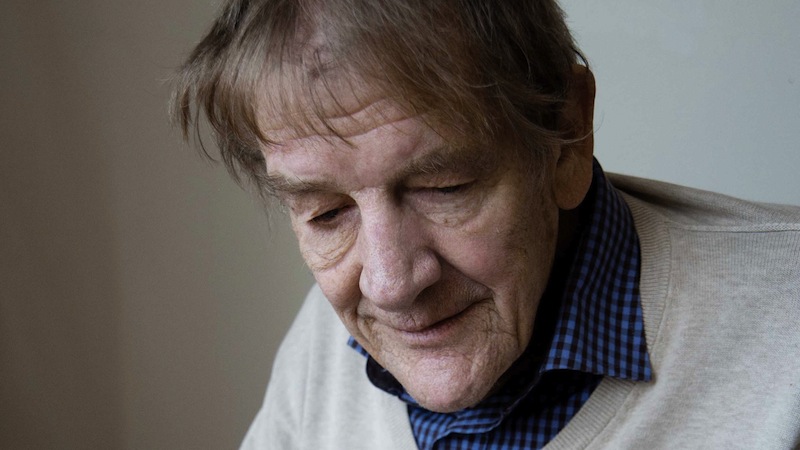Momenta makes Nørgard quartets a rewarding journey
At 84 years old, Danish composer Per Nørgard is only now enjoying a substantial presence in New York. The Philharmonic concluded their 2016 Biennial with the American premiere of his Symphony No. 8, and this week is ending with the three-concert series “Nørgard in New York,” at Scandinavia House.
Friday night, in the second of the three programs, the Momenta Quartet played four of the composer’s ten string quartets, along with a duo and trio piece. The six compositions–all but two heard in their American premieres– delivered a compact overview of his development as a composer and a potent taste of his voice at its most compelling.
That voice came through strongly in Nørgard’s String Quartets 8 and 10, and the violin solo Playground, all from the last twenty years. The earlier String Quartets 3 and 5, and the violin and cello duo Tjampuan (1992), were relatively lesser works, but the opportunity to hear them together proved rewarding.
Nørgard worked his way through a flavor of modernism that came out of late romantic expressionism, and his thinking was refreshed by non-Western ideas, specifically the music of Bali. What that led to was what he calls his “Infinity Series,” a serial-inspired structure, but with a heavy dose of microtonality spinning around a diatonic center.
At its best, this microtonality opens up the landscape of his pieces, though it shaves pitches into smaller, tighter units. The String Quartet No. 5, “Inscape” (1969) used it for an older, European sound, and the concentration on expressionistic gestures made for a claustrophobic listening experience.
No fault of Momenta, which was outstanding all night, not just sensitive and precise, but exquisitely exact in their microtonal playing. Nor is this critical of Nørgard—the style was a common practice in the last century. If Nørgard in 1969 was not quite the composer he would become, then one can’t fault his patient development.
The earlier works were pieces of the puzzle that became the mature music. Momenta opened with String Quartet No. 3, “Three Miniatures” (1959), three movements that in total last under five minutes. The musicians played individual patterns that wove themselves together into rhythms and counterpoints, and everyone had inventive melodies full of folk feeling and the flavor of great Scandinavian predecessors, like Sibelius and Nielsen. The brevity was part of its wit.
“Inscape” was psychologically dense and rhythmically plodding. The two movements are based on the same, single quarter-tone scale, which produced monotony, along with a closed and turgid internal narrative. Momenta pushed their way through the music, but could not bring it to life until the coda, where the piece transformed into bright, limpid section.
Tjampuan was played by violinist Alex Shiozaki and Momenta cellist Michael Haas. The duo expresses Nørgard’s interest in Indonesian culture via structure. The title is the Indonesian word for the meeting point of two rivers, and the two instruments played separate solo lines for much of the work, until they came together near the end. Like “Inscape,” the results were often gray, personal to the point of being hermetic. The integration of the two instruments made for a subtle change, when a starker contrast would have had a stronger affect—as in the end of “Inscape.”
These pieces were all parts of a cumulative whole, however and the fruition of Nørgard’s ideas in Playground and the later quartets was tremendous. Emilie-Anne Gendron was the soloist for Playground, a vivacious etude. Heard after String Quartet No. 3, the music carried its playfulness through melodies that were full of lively rhythms. It was a virtuosic expression of both the composer’s craft and Gendron’s playing.
Quartet No. 8, “Night Descending Like Smoke,” and Quartet No. 10, “Harvest Timeless,” (1997 and 2005 respectively), were distinctive and powerful. Their free-floating microtonality was both abstract and earthy, with a haunting sound that lay like gossamer over bottomless depths.
Quartet 8 uses material from Nørgard’s chamber opera The Night of Mankind, and the performance painted the picture of a world falling into physical and moral entropy. There were agitated moments, but the experience was of a series of eerie, quasi-folk songs that were all parts of one long lament. Haas played a solo line with a sound like a musical saw, and the dry, vocalized timbres throughout, as well as the real-time scordatura, made for an uncanny, spine-tingling performance.
The final quartet had much of the same microtonal uncanniness, and the mood was often sorrowful. But the music was graceful, with a gently rocking pulse that carried the single movement. With its development and variations, it sounded like a rondo, and the melodies included a subtly disguised waltz. It was as inward-looking as some of the earlier music, but traded monomania for free association. Where the earlier pieces sometimes seemed to hold their breath for as long as possible, this one breathed, and the playing was full of life.
“Nørgard in New York” concludes with works for large ensemble, played by Lost Dog New Music Ensemble and soloists 8 p.m. Saturday at Scandinavia House. norgardinnewyork.org




Posted Jan 08, 2017 at 2:35 am by Christopher Culver
“What that led to was what he calls his “Infinity Series,” a serial-inspired structure, but with a heavy dose of microtonality spinning around a diatonic center.”
Your description is misleading. The infinity series is not a microtonal thing — it is a principle that Norgard has almost invariably applied to the traditional diatonic or chromatic scales except for a small handful of works (none of which were performed in this programme). See the description of the infinity series of PerNoergaard.dk.